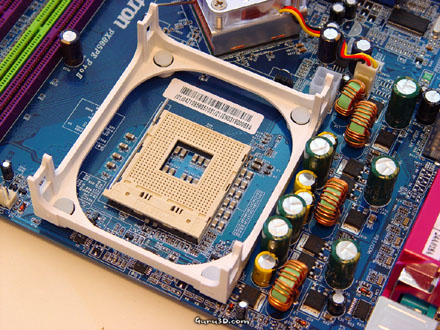Page 6 - Overclocking & ForceWare
ForceWare DriverWe are not going through all the driver options again and again after each review. Just the standard information. As you know we always try to take it one step further, hey we are Guru3D.com. Several properties are hidden at default and for the advanced users among us these settings are quite interesting, you can enable it by downloading the Hidden Features patch from our Detonator driver file section.

Once you've installed the patch you'll be able to overclock the graphics card ;)

As you can see this card runs at 39 degrees C at idle. We recorded it at 60 C when the GPU was working 100%. Very normal values.
Performance & Overclocking
Before we dive into a large series of benchmarks we need to discuss overclocking. With most videocards, we can do some easy tricks to boost the overall performance a little. It's called overclocking the videocard. By increasing the frequency of the videocard's memory and GPU we can make the videocard increase its calculation clock cycles per second. It sounds hard but it really can be done in just a few minutes. I always tend to recommend to novice users and beginners not to increase that frequency any higher then 5-10% of the core and memory clock. Example: If your card would run at 300 MHz then I suggest you don't increase that frequency any higher than 330 MHz.
More advanced users push that frequency higher, often way higher. Usually when games start to show white dots ("snow") you should go down 10 MHz and leave it at that. The core can be somewhat different. Usually when you are clocking too hard it'll start to show artifacts, empty polygons or it will even freeze. I recommend that you back down at least 15 MHz from the moment you notice an artifact. Look carefully and observe well.
All in all... do it at your own risk. Overclocking your card too fast or constantly to it's limit might damage your card and it's usually not covered by your warranty.
You will benefit from overclocking the most with a product that is limited or you may called it "tuned down." We know that this graphics core is often limited by tact frequency or bandwidth limitation, therefore by increasing the memory and core frequency we should be able to witness some higher performance results. A simply trick to get some more bang for your bucks.
The Tornado GeForce FX 5700 Ultra from InnoVision, at standard 128-bit 128 MB GDDR3 memory runs at default 475 MHz for the core and 950 MHz for its memory. The 5700 was a pretty solid overclocker with 550 MHz as its core frequency and 1.12 GHz for the memory which definitely had an impact on the overall score.
These settings have been used throughout our entire benchmark suite. That means that each card has been tested on the overclocked conditions in twenty-eight individual tests without corruption or weirdness in the form of system hangs.
| Test system |
|
Benchmark Software Suite:
* For four of these games we are making use of a custom time demo. Neither NVIDIA nor ATI knows what time demo we are using. These are non-public tests that were recorded for us only. We are not going to make them public either as they are and will remain internal material. Therefore the chipset manufacturer will not have the chance of optimizing it to that specific benchmark time-demo. We will do our very best now and in the future to keep a close eye on optimizations and cheats, we need to be able to show you objective results. However in the end this should be a responsibility for the chipset designer, if that entity fails to do so, then it'll lose consumer's trust and will dig it's own grave. |
All tests were made in 32 bit colors in resolutions ranging from 800x600 pixels up-to the Godfather of all gaming resolutions, 1600x1200, with several performance/quality settings.

